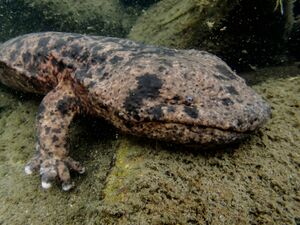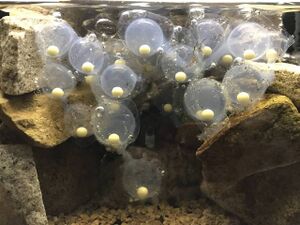Japanese giant salamander: Difference between revisions
m The LinkTitles extension automatically added links to existing pages (<a rel="nofollow" class="external free" href="https://github.com/bovender/LinkTitles">https://github.com/bovender/LinkTitles</a>). |
|||
| (69 intermediate revisions by 2 users not shown) | |||
| Line 1: | Line 1: | ||
The '''Japanese giant salamander''' (''Andrias japonicus'') is one of the five species of salamander found to be a member of the family Cryptobranchidae. This family is defined by it consisting of the largest living amphibians, along with all members being fully aquatic [[salamanders]]. With a length of up to 5 feet,<ref name = amphibiaweb> Yoshio Kaneko, Masafumi Matsui (2004). http://amphibiaweb.org/cgi-bin/amphib_query?query_src=aw_lists_genera_&table=amphib&where-genus=Andrias&where-species=japonicus ''Andrias japonicus'' Retrieved 05/09/2022</ref> the Japanese giant salamander is the third largest species of salamander living. They are highly endemic being found in southwestern Japan (west of Gifu Prefecture in Honshu and parts of Shikoku and Kyushu) in fast flowing mountain streams. <ref name = amphibiaweb></ref> | |||
{| class="wikitable" style="text-align:center; float:right; margin-left: 10px; | {| class="wikitable" style="text-align:center; float:right; margin-left: 10px; | ||
|+ !colspan="2" style="min-width:12em; text-align: center; background-color: rgb(235,235,210)|'''Scientific Classification''' | |+ !colspan="2" style="min-width:12em; text-align: center; background-color: rgb(235,235,210)|'''Scientific Classification''' | ||
| Line 28: | Line 31: | ||
|} | |} | ||
== Description == | == Description == | ||
Japanese giant salamander typically are around 5 feet in length and weight around 55 pounds. The brown and black skin camouflages the species amongst river beds and rock formations with the body having distant warts. Higher concentrations of warts are found on the species head. This one species neck has large skin flaps assisting in regulation of carbon dioxide and oxygen exchange.<ref>{{Cite web|url=https://animaldiversity.org/accounts/Andrias_japonicus/|title=''Andrias japonicus''|website=Animal Diversity Web|language=en|access-date=2018-03-28}}</ref> It has very small eyes with no eyelids limiting the species vison. 'A. japonicus' mouth is the width of its entire head and can open as wide as the species body, allowing for capture of larger prey.<ref name="natlzoo"/> | |||
== Diet == | == Diet == | ||
With the Japanese | With the Japanese giant salamander living its entire life in the water the diet consists of freshwater fish, frogs, and crabs. Due to the slow metabolism of the salamander the species can go without eating for days.<ref name="natlzoo">{{cite web|url=https://nationalzoo.si.edu/Animals/AsiaTrail/GiantSalamanders/|website=Smithsonian National Zoological Park|access-date=2016-06-13|title=Japanese Giant Salamander|archive-url=https://web.archive.org/web/20160624015515/http://nationalzoo.si.edu/Animals/AsiaTrail/GiantSalamanders/|archive-date=2016-06-24|url-status=dead}} Retrieved 5/9/2022</ref> With the species large size it has no natural predators. | ||
Due to the poor eyesight of the species it relies on a lateral line sensory system, with cells covering the Japanese giant salamanders. These cells detect vibrations in their environment and are essential for hunting. | |||
== Behavior == | == Behavior == | ||
The Japanese giant salamander occurs in freshwater locations ranging from relatively large rivers (20-50 m) to small headwater streams (0.5 - 4 m), due to the abundance of oxygen. | |||
This is required for the Japanese giant salamander with its large size and lack of gills present. | |||
Compared to other salamanders the species remains in the water for its entire life due to it not having gills and does not live on land post metamorphosis. Japanese giant salamanders come to the surface to lie its head on the surface of the stream to get oxygen without going on land. | |||
=== Reproduction === | |||
[[File:Salamander_eggs.jpg|right|thumb|Japanese giant salamander eggs. Retrieved from https://www.staradvertiser.com/2018/11/09/hawaii-news/breeding-pair-of-japanese-giant-salamanders-make-history-in-honolulu/]] | |||
During the mating season, typically in late August and early September, sexually mature males start actively finding suitable nesting sites and often migrate upstream into smaller sections of the river or its tributaries. Nesting sites are highly sought after and are extremally competitive, leading to bigger individuals settling these areas and are considered den-masters.<ref name = amphibiaweb></ref> These den masters protect their nests against other males and during breeding season females are allowed to come in and lay their eggs in these dens. Den-masters fertilize these eggs however other male Japanese giant salamanders fertilize these eggs due to a males semen stimulating other hiding males to join the breeding meaning a female may end up breeding with multiple males.<ref name = amphibiaweb></ref> Researchers have shown that den-masters can be cannibalistic with its own unfertilized eggs theorizing "hygienic filial cannibalism", which implies selection and consumption of those to not spread disease or prevent the growth of the healthy eggs. | |||
== Conservation == | == Conservation == | ||
Due to the species being highly endemic, the biggest threat to the Japanese | ===Threats=== | ||
Due to the species being highly endemic, the biggest threat to the Japanese giant salamander is habitat loss. This is due to human activity damming up riverbeds and freshwater sources occupied by the giant salamander. Climate change is also a source for concern to the Japanese giant salamander due to estimated rainfall increasing leading to the destruction of streambeds.<ref>Ministry of the Environment, Ministry of Education, Culture, Sports, Science and Technology, Ministry of [[Agriculture]], Forestry and Fisheries, Ministry of Land, Infrastructure, Transport and Tourism, & Japan Meteorological Agency (2018): Climate change in Japan and its impacts. – Synthesis Report on Observations, Projections and Impact Assessments of Climate Change, 2018 Retrieved 05/9/2022 </ref> This introduction of the Chinese giant salamander has lead to hybridization between the two species, posing a big threat to the native species. Studies done from 2011 to 2013 showed that 95% of all Japanese giant salamanders captured were hybrids, and were captured in multiple locations.<ref name="natlzoo"> </ref> | |||
[[File:Andrias_japnonicus_distribution.gif|left|thumb|Japanese giant salamander range. Retrieved from https://en.wikipedia.org/wiki/Japanese_giant_salamander#/media/File:Andrias_japonicus_distribution.gif ]] | |||
=== Efforts === | |||
The Japanese giant salamander was declared a special natural monument in 1951<ref>{{cite web|script-title=ja:オオサンショウウオ|url=https://kunishitei.bunka.go.jp/heritage/detail/401/3129|access-date=2011-09-24|publisher=The Agency for Cultural Affairs|language=ja}}</ref>, federally protecting the species protection. Despite this federal oversight no conservation efforts have been initiated by the government leading non-profits to conduct population assessments themselves, with organizations such as The Japanese Giant Salamander Society promoting conservation education of the species. No efforts have been taken as of today which is detrimental to the | |||
recorded decline of the species population. | |||
== References == | == References == | ||
{{reflist}} | |||
Latest revision as of 13:06, 10 May 2023
The Japanese giant salamander (Andrias japonicus) is one of the five species of salamander found to be a member of the family Cryptobranchidae. This family is defined by it consisting of the largest living amphibians, along with all members being fully aquatic salamanders. With a length of up to 5 feet,[1] the Japanese giant salamander is the third largest species of salamander living. They are highly endemic being found in southwestern Japan (west of Gifu Prefecture in Honshu and parts of Shikoku and Kyushu) in fast flowing mountain streams. [1]

| |
| Kingdom: | Animalia |
|---|---|
| Phylum: | Chordata |
| Class: | Amphibia |
| Order: | Urodela |
| Family: | Cryptobranchidae |
| Genus: | Andrias |
| Species: | A. japonicus |
| Source: Integrated Taxonomic Information System[2] | |
Description
Japanese giant salamander typically are around 5 feet in length and weight around 55 pounds. The brown and black skin camouflages the species amongst river beds and rock formations with the body having distant warts. Higher concentrations of warts are found on the species head. This one species neck has large skin flaps assisting in regulation of carbon dioxide and oxygen exchange.[3] It has very small eyes with no eyelids limiting the species vison. 'A. japonicus' mouth is the width of its entire head and can open as wide as the species body, allowing for capture of larger prey.[4]
Diet
With the Japanese giant salamander living its entire life in the water the diet consists of freshwater fish, frogs, and crabs. Due to the slow metabolism of the salamander the species can go without eating for days.[4] With the species large size it has no natural predators.
Due to the poor eyesight of the species it relies on a lateral line sensory system, with cells covering the Japanese giant salamanders. These cells detect vibrations in their environment and are essential for hunting.
Behavior
The Japanese giant salamander occurs in freshwater locations ranging from relatively large rivers (20-50 m) to small headwater streams (0.5 - 4 m), due to the abundance of oxygen. This is required for the Japanese giant salamander with its large size and lack of gills present.
Compared to other salamanders the species remains in the water for its entire life due to it not having gills and does not live on land post metamorphosis. Japanese giant salamanders come to the surface to lie its head on the surface of the stream to get oxygen without going on land.
Reproduction

During the mating season, typically in late August and early September, sexually mature males start actively finding suitable nesting sites and often migrate upstream into smaller sections of the river or its tributaries. Nesting sites are highly sought after and are extremally competitive, leading to bigger individuals settling these areas and are considered den-masters.[1] These den masters protect their nests against other males and during breeding season females are allowed to come in and lay their eggs in these dens. Den-masters fertilize these eggs however other male Japanese giant salamanders fertilize these eggs due to a males semen stimulating other hiding males to join the breeding meaning a female may end up breeding with multiple males.[1] Researchers have shown that den-masters can be cannibalistic with its own unfertilized eggs theorizing "hygienic filial cannibalism", which implies selection and consumption of those to not spread disease or prevent the growth of the healthy eggs.
Conservation
Threats
Due to the species being highly endemic, the biggest threat to the Japanese giant salamander is habitat loss. This is due to human activity damming up riverbeds and freshwater sources occupied by the giant salamander. Climate change is also a source for concern to the Japanese giant salamander due to estimated rainfall increasing leading to the destruction of streambeds.[5] This introduction of the Chinese giant salamander has lead to hybridization between the two species, posing a big threat to the native species. Studies done from 2011 to 2013 showed that 95% of all Japanese giant salamanders captured were hybrids, and were captured in multiple locations.[4]

Efforts
The Japanese giant salamander was declared a special natural monument in 1951[6], federally protecting the species protection. Despite this federal oversight no conservation efforts have been initiated by the government leading non-profits to conduct population assessments themselves, with organizations such as The Japanese Giant Salamander Society promoting conservation education of the species. No efforts have been taken as of today which is detrimental to the recorded decline of the species population.
References
- ↑ 1.0 1.1 1.2 1.3 Yoshio Kaneko, Masafumi Matsui (2004). http://amphibiaweb.org/cgi-bin/amphib_query?query_src=aw_lists_genera_&table=amphib&where-genus=Andrias&where-species=japonicus Andrias japonicus Retrieved 05/09/2022
- ↑ "Integrated Taxonomic Information System - Report", ITIS USGS Open-File Report 2006-1195: Nomenclature", USGS, n.d.. Retrieved 5/9/2022.
- ↑ “Discover How Scientists Have Recreated the Benefits of Insects' Compound Eyes as Compound Lenses.” Encyclopædia Britannica, Encyclopædia Britannica, Inc., https://www.britannica.com/video/216533/Artificial-bug-eyes-could-lead-to-new-vision-systems.
- ↑ 4.0 4.1 4.2 “Discover How Scientists Have Recreated the Benefits of Insects' Compound Eyes as Compound Lenses.” Encyclopædia Britannica, Encyclopædia Britannica, Inc., https://www.britannica.com/video/216533/Artificial-bug-eyes-could-lead-to-new-vision-systems. Retrieved 5/9/2022
- ↑ Ministry of the Environment, Ministry of Education, Culture, Sports, Science and Technology, Ministry of Agriculture, Forestry and Fisheries, Ministry of Land, Infrastructure, Transport and Tourism, & Japan Meteorological Agency (2018): Climate change in Japan and its impacts. – Synthesis Report on Observations, Projections and Impact Assessments of Climate Change, 2018 Retrieved 05/9/2022
- ↑ “Discover How Scientists Have Recreated the Benefits of Insects' Compound Eyes as Compound Lenses.” Encyclopædia Britannica, Encyclopædia Britannica, Inc., https://www.britannica.com/video/216533/Artificial-bug-eyes-could-lead-to-new-vision-systems.